- Sep 17, 2013
- 85
If you get some nice dry wood that is to old, let us know. Maybe we can help you out.
I know its funny but I was told this by the person with the wood and before this post I did not know anything about this.
If you get some nice dry wood that is to old, let us know. Maybe we can help you out.
I live in an old farm rural area where every other house has a barn (nearly).
My five year old knows, if a barn is falling down, it's because they didn't take care of the roof.
Keep the internals dry, and you keep the structure.
The analogy follows to the firewood..... especially if it's more than 2 rows deep.
Ok I understand, thanks. Someone mentioned there is a point when the wood starts to turn and provides less heat and shorter burns. Is there any indicators, visual or other, when this starts to happen? Not sure if there is there any relevance in worrying about it. The reason I ask is because this wood may sit for some time before I get a stove.
It depends on the species and the wood for where you'll find punk. In general, with any species, if it's solid from center to bark, then once it's split and stacked, so long as you don't keep it in a swamp, and it has good air, you won't have a problem with it turning to punk.
Punk is when the wood will turn spongy compared to any of the solid wood that is left. Even if the punk is dry, it will feel softer to the touch, look fuzzy, not be as heavy, as that species of wood should normally be.
It will look rotten.So I guess it's not that it becomes useless or a danger but just less effective the older it is. How can you tell when it's starting to go from perfect to downhill.
I just got a bunch of free wood. I'm wondering whats the best way to store wood? Here is what I have found so far.
Where in RI are you? I didn't cover my stacks for awhile when I first started, but found with our weather up here the wood can stay soaked for a week at a time. I recommend top covering right away (I use 6mil plastic with scrap plywood on top).
I just got a bunch of free wood. I'm wondering whats the best way to store wood? Here is what I have found so far.
Single row is best
location with good air flow and sun
Not sure if this is correct. Also not sure if the wood should be covered.
Still not sure if I should be covering this wood. And if I should be do I only cover the top or the entire stack. Also if just the top is it best to have a small wood roof over it or a tarp.
Cool thanks. I was also wondering if the wood has a shelf life? I was told after a certain time the wood is no longer good to burn indoors, is this true?
So I guess it's not that it becomes useless or a danger but just less effective the older it is. How can you tell when it's starting to go from perfect to downhill.
Do you cover the entire stack with the tarp?
If water is the enemy wouldn't you need to cover the entire stack so it does not get rained on or have snow pile up next to it in the winter? Or would doing this have a negative effect because it would trap moisture and prevent air movement?
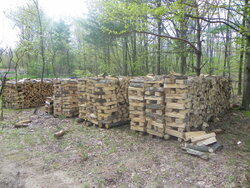
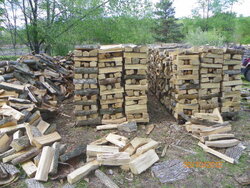
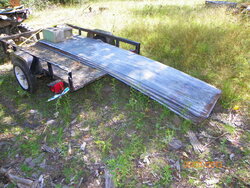
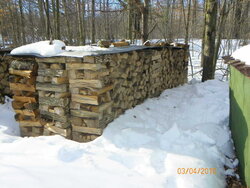
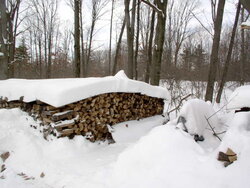
Frank, I don't remember if I did or not, so here it is. Welcome to the forum.
You have lots of questions there and they are all good ones. This shows you are well on your way to doing things right. It could help if we knew where you are located and you can put that information in your signature line or just fill out your profile page.
Single rows or multiple? That certainly depends. What kind of wood, where you live (lots of rain/snow?), how long you can let the wood dry and how you keep the wood can all give some different answers. First, we recommend folks be 3 years ahead on their wood piles as then you won't have problems and the benefits are tremendous.
We have stacked in single rows, double, triple and as many as 20 or more rows right together. For the most part, this is how we stack:
View attachment 114104 View attachment 114105
You will notice under the stacks are some round poles. These we just cut in the woods or even sometimes use limbs. Some folks will use pallets; some lay down cement blocks and then lay 2 x 6 or something similar on the blocks. Even railroad ties or landscape timbers will work well. Our method is just a lot cheaper and it works. It allows for the wood to not touch ground and also gives some air circulation under the wood. Some will claim the center rows won't dry as well as the outer rows but that has never been our experience. They seem to dry at the same rate.
After we stack the wood (usually in April) we leave the wood like that until early winter or just before the snow flies. For those who live in very wet climates, it would be best to top cover right after stacking and we use old galvanized roofing for the covering. This is how we cover:
View attachment 114109 View attachment 114110 View attachment 114108
I will add that we did things this way for many years but now have a place in the barn to store some wood. In October we will move enough wood into the barn for what we plan on burning through the winter. I would also advise anyone who has a wood shed that it is still best to dry the wood outdoors before moving it into a shed. Also, we try to make sure all our wood has dried for 3 years but have burned wood that has been up to 10 years in the stack. It burns very nicely this way and we have no creosote concerns.
On covering the wood. Definitely cover the top only. Do not worry about rain and snow hitting the sides and ends of the stacks. Wood is not a sponge and that wetness will dry usually within 24 hours after a rain. You might notice in the last picture above that the wood had a bunch of snow around it and some up to 3' on the ends. No problems with this at all. However, if you cover your entire stack, you will trap in all the moisture that you want to get out of the wood. Until we learn how to best burn water, we'll keep top covering.
How long can you leave wood? We've known folks to burn wood that has been 10-15 years in the stack or in a shed. It still burns nicely.
I hope this helps.
Your ahead of the game getting wood collected before you even have a stove to burn it in. Everyone will come up with their own way of doing things for their space situation. I used tarps last year and brought a weeks worth of wood at a time into the garage. This year, I moved a whole cord into the garage and I built some covers with lightweight corrugated asphalt panels. I plan on building more of a covered crate with the covers, rather than a shed, to store the wood going forward. Lot's of good ideas for firewood cover material searching the forums.Bristol. I think I'm going to make a small removable wood roof to cover the tops that will rest on the rack. This way I don't have to deal with the tarps and plastic blowing around or pooling water.
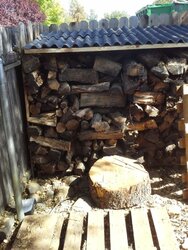 and 2x3's.
and 2x3's.I just got a bunch of free wood. I'm wondering whats the best way to store wood? Here is what I have found so far.
Single row is best
location with good air flow and sun
Not sure if this is correct. Also not sure if the wood should be covered.
I see most of you get your wood up off the ground if I don't do that I figure I just have a few sticks on the bottom that may rot. Or do you find the the whole stack wicks up moisture from the ground and doesn't dry as good.

